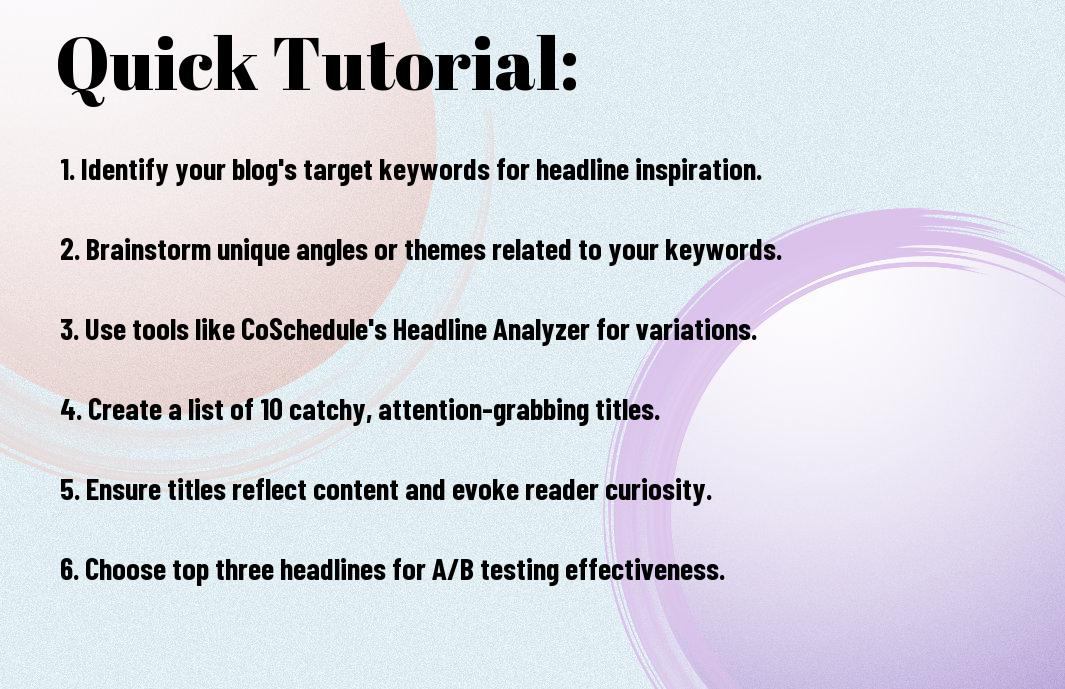Are you ready to invigorate your content with captivating headlines? In this tutorial, you’ll discover ten unique and engaging blog titles tailored to resonate with your specific keywords. An alluring headline can significantly enhance your readers’ experience and improve your page’s SEO. By the end, you’ll have an arsenal of creative titles that not only reflect your content but also entice your audience to click and engage. Let’s dive in!

Key Takeaways:
- Unique Titles: The blog’s focus is on generating creative and engaging titles that can capture readers’ attention, ensuring they stand out from typical headlines.
- Keyword Relevance: The headlines are tailored to specific keywords, enhancing the blog’s visibility and relevance in search engines.
- Audience Engagement: Thoughtfully crafted titles contribute significantly to audience engagement, leading to higher click-through rates and increased readership.
Understanding the Importance of Engaging Blog Headlines
While you may pour your heart and soul into writing a blog post, if your headlines don’t resonate with your audience, those efforts can go unnoticed. Engaging blog headlines serve as the first impression for your content, and you only get one shot at making it. Without a captivating headline, even the most informative and beautifully written content can become just another entry in the vast sea of blogs online. Your goal should be to grab your reader’s attention immediately, enticing them to click and read further.
Why Headlines Matter in Blogging
Assuming you’ve spent time crafting insightful content, the next step is to ensure that your audience even sees it. Headlines are the initial point of contact; they must be engaging enough to spark curiosity and compel readers to explore further. A powerful headline can be the difference between a bounce and a click. When you create a headline that intrigues or promises value, you create an opportunity for your content to reach more viewers.
The Role of Headlines in Search Engine Optimization (SEO)
Headlines are not just important for grabbing attention; they also play a significant role in SEO. When you optimize your headlines with relevant keywords, you increase the likelihood of your blog appearing in search results. This, in turn, helps you attract organic traffic, as search engines prioritize well-structured and keyword-rich titles. By understanding the balance between crafting engaging headlines and incorporating SEO best practices, you can significantly improve your blog’s visibility online.
This means that as you create your headlines, you should consider both the emotional resonance you want to achieve and the potential for searchability. In short, a great headline not only piques interest but also aligns with the algorithms of search engines, making it easier for your target audience to find your content amidst the noise of the internet.

Crafting Unique and Engaging Blog Headlines
If you want your blog to stand out in a crowded digital landscape, crafting unique and engaging headlines is imperative. Your headline is the first impression your readers will have of your content, and it can significantly influence their decision to click and read further. To create effective headlines, it’s crucial to understand your target audience and how to resonate with their interests and preferences.
Identifying Your Target Audience
Blog headlines should be tailored to appeal to the specific demographics and psychographics of your readers. Start by identifying who your ideal audience is, including their age, background, interests, and pain points. This understanding will help you create headlines that speak directly to their needs, grabbing their attention and encouraging them to engage with your content.
Once you know your audience, pay attention to the language and tone they resonate with. Are they looking for informative tips, entertaining anecdotes, or thought-provoking insights? By using language that reflects your audience’s voice, you ensure your headlines are not only appealing but also relatable, setting the stage for a deeper connection with your readers.
Using Keywords Effectively
To attract organic traffic to your blog, you must strategically incorporate keywords into your headlines. Begin by researching relevant keywords that potential readers are searching for. Including these keywords in your headlines not only helps with SEO but also gives your readers a clear idea of what to expect from your content.
Keywords should be placed in prominent positions within your headlines, ideally towards the beginning, to maximize visibility and impact. However, balance is key; while you want to include keywords, make sure your headlines remain natural and engaging. Avoid keyword stuffing, as this can lead to bland or confusing headlines that fail to captivate your audience.
Keywords can also help you connect with your audience’s intent. For example, if people are searching for “how to” guides, incorporating this phrase into your headline can significantly increase click-through rates, demonstrating that you understand what they are looking for.
Creating Attention-Grabbing Phrases
Phrases that invoke curiosity or a sense of urgency can make your headlines more compelling. Consider using action verbs or posing questions that encourage readers to think. Headlines like “Discover the Secrets to…” or “Are You Making These Common Mistakes?” can provoke readers to learn more while building a connection with them through an implied promise of value.
When crafting these phrases, focus on conveying the main benefit of your blog post succinctly. Think about what readers stand to gain by clicking your headline. The more you can align with their desires, the more likely you are to draw them into your content.
Audience engagement hinges on your ability to create enticing phrases that resonate. By blending emotion, promise, and urgency into your headlines, you position your article as a must-read, generating interest and clicks efficiently.
Exploring Different Types of Blog Headlines
Unlike many creative pursuits, crafting the perfect blog headline can significantly affect your blog’s visibility and audience engagement. Understanding various headline types can enhance your writing and captivate your readers. Here’s a breakdown of the most common headline types and how you can utilize them effectively.
- Question-Based Headlines
- Statement-Based Headlines
- How-To Headlines
- List-Based Headlines
- Command Headlines
This exploration will lead you to discover which style resonates most with your intended audience.
| Headline Type | Description |
|---|---|
| Question-Based Headlines | These headlines provoke curiosity by posing a question. |
| Statement-Based Headlines | These headlines make bold declarations or claims to grab attention. |
| How-To Headlines | These provide a clear promise of helpful information. |
| List-Based Headlines | These outline specific items or tips, appealing to readers seeking concise information. |
| Command Headlines | These use direct language to urge readers to take action. |
Question-Based Headlines
An excellent strategy for engaging your audience is to use question-based headlines. By asking a question, you instantly invite your readers into a conversation. This type of headline can evoke curiosity, leading them to want to find the answer or learn more about the topic you’re discussing. Whether it’s “Are You Making These Common Blogging Mistakes?” or “How Can You Increase Your Blog’s Readability?”, these headlines prompt readers to consider their own experiences and engage with your content further.
Additionally, question-based headlines can serve as a tool to identify your audience’s pain points. By directly addressing common queries or concerns, you position yourself as a valuable resource, enhancing both credibility and relatability. When you generate this type of content, remember to keep your questions focused to ensure clarity and effectiveness. Use what you know about your audience’s interests to craft compelling questions that resonate.
Statement-Based Headlines
While question-based headlines are centered around curiosity, statement-based headlines create an element of certainty and authority. These headlines often declare facts, insights, or opinions that grab attention immediately. For instance, headlines such as “The Secret to Successful Blogging Is Simplicity” make strong assertions that pique interest and encourage readers to explore further. They convey confidence and establish your voice as an expert in your niche.
Moreover, statement-based headlines can provoke strong reactions, sparking discussions among your audience. By articulating opinions or controversial views, you invite readers to either agree or challenge your perspective, fostering interaction through comments and shares. This style can enhance your visibility and strengthen your community by encouraging active engagement.
With the right approach, statement-based headlines can effectively portray your unique viewpoint while enticing readers to explore into your content.
How-To Headlines
The appeal of how-to headlines lies in their promise of clear guidance. They provide readers with valuable information and a sense of direction. Examples include “How to Write Effective Blog Headlines That Attract Attention” or “How to Boost Your Blog’s SEO in Five Simple Steps.” Such headlines assure your audience that they will leave with actionable knowledge, making them more likely to click through.
In your writing, employing how-to headlines allows you to share your expertise and help your audience solve problems or learn new skills. This not only builds trust but positions you as a reliable source for quality information. By offering step-by-step guidance, you cater to the common desire for clarity amidst the vast array of information available online.
Headlines that promise a specific outcome do wonders in converting clicks into loyal followers, as readers often appreciate clear frameworks to navigate complex topics.
List-Based Headlines
On the other hand, list-based headlines are known for their straightforwardness and effectiveness. By presenting information in a numbered format, you help readers easily digest and retain the content. Examples like “7 Tips for Effective Time Management” or “10 Must-Read Blogs for Entrepreneurs” signal that your post will deliver succinctly organized insights, making it appealing to those who appreciate quick reads.
This structure not only grabs attention but also sets clear expectations about the content’s format. Readers in this fast-paced digital age often prefer bite-sized pieces of information that they can quickly skim, making list-based headlines a powerful strategy in your blogging arsenal.
To effectively use list-based headlines, consider the time and effort your readers save when they can easily identify valuable takeaways from your posts.
Analyzing the Anatomy of a Great Blog Headline
To craft a compelling blog headline that grabs attention, you must understand the various components that contribute to its effectiveness. A great headline doesn’t just inform; it entices readers to click through and engage with your content. From emotional triggers to powerful action verbs, every element plays a significant role in how your headline will perform. Let’s investigate into the different aspects that make up a strong blog headline and explore how you can implement these strategies in your writing.
The Power of Numbers in Headlines
Assuming you are trying to attract readers who are scrolling through numerous articles, incorporating numbers into your headlines can significantly increase their attractiveness. Headlines that feature numbers are often perceived as more actionable and informative. For example, “7 Proven Strategies to Boost Your Blog Traffic” immediately communicates a clear benefit, offering readers a defined takeaway. Numbers create structure, making it easy for readers to gauge the length and comprehensibility of the article before they commit to reading.
Moreover, numbers tend to stand out in a sea of text. They break the monotony and draw the eye directly to your headline. Whether it’s using a specific count, like “10 Ways,” or a broader range, like “A Few Tips,” the numerical element should not be overlooked. You might find that headlines with numbers perform better in terms of shares and clicks, making them a powerful tool in your blogging arsenal.
The Importance of Emotional Triggers
One of the most effective ways to connect with your audience is by leveraging emotional triggers within your headlines. Emotional headlines evoke feelings, whether they be curiosity, urgency, fear, or happiness, prompting readers to engage with your post. For instance, a headline like “How to Overcome Your Biggest Fears in 5 Simple Steps” appeals directly to those struggling with anxiety or self-doubt, effectively drawing them in. When you tap into the emotions of your readers, you’re more likely to capture their attention and encourage them to click through to your content.
Headlines that elicit strong emotional responses pave the way for deeper engagement. By understanding your audience’s pain points or desires, you can tailor your headlines to resonate on a personal level. Use words that promise transformations, spark curiosity, or ignite a sense of urgency. This emotional connection can compel readers to probe your content with a more invested mindset.
Using Action Verbs to Drive Engagement
Drive engagement by incorporating strong action verbs in your blog headlines. Action verbs give your headlines energy and urgency, motivating your readers to take immediate action. Instead of saying, “The Benefits of Yoga,” you could frame it as “Transform Your Life with These 5 Powerful Yoga Techniques.” The latter not only informs but also encourages the reader to explore and experience those benefits, reinforcing their need to click on your article.
Using action verbs adds a dynamic quality to your headlines, propelling your readers towards a desired outcome. These verbs are necessary in crafting headlines that encourage excitement and exploration, inviting potential readers to engage with your content actively. With the right selection of action verbs, you can boost your headline’s impact, enhancing its effectiveness in drawing in your audience.
Tips for Writing Compelling Blog Headlines
Many bloggers struggle with crafting headlines that grab attention and entice readers to click through to their content. A compelling headline not only informs readers about the article’s content but also sparks curiosity and encourages engagement. Here are some tips to help you create captivating headlines:
- Incorporate strong keywords relevant to your content.
- Use numbers or lists to attract readers’ interest.
- Pose questions that provoke thought or curiosity.
- Highlight the benefits or value your post offers.
- Experiment with different formats to see what resonates with your audience.
Assume that the headline is your first impression; taking the time to craft it wisely can lead to significantly improved click-through rates and reader engagement. If you’re looking for more inspiration, check out 60+ Catchy Headline Examples to Inspire You in 2023.
Keeping it Concise and Clear
Keeping your blog headlines concise and clear is vital for effective communication. Aim for a headline length that is easy to read at a glance—ideally around 60 characters or less. This will ensure that your titles aren’t cut off on search engine results pages or social media, maintaining their clarity and impact. A precise headline also helps convey your message more clearly, which can lead to better engagement from your audience.
Additionally, ensure that your headline directly reflects the content of your blog post. When readers find what they expected based on the headline, they’re more likely to trust your content and return for future reads. Avoid jargon or overly complex phrases that might confuse your audience; simpler is often better.
Using Humor and Wit
If you want your headlines to stand out, consider incorporating humor and wit. A clever or funny title can be incredibly enticing, as it often piques readers’ interest and encourages them to click through to your post. You can tap into pop culture references, puns, or playful wordplay to make a memorable impression. Just be cautious—humor can be subjective, so ensure that it aligns with your target audience’s values and preferences.
Plus, don’t be afraid to showcase your personality in your headlines. This can help you build a connection with your audience and make your content more approachable. When readers see that you don’t take yourself too seriously, they might be more inclined to engage with your content and share it with others. Just remember, humor shouldn’t overshadow the main message of your post.
Creating a Sense of Urgency
You can drive more traffic to your blog posts by creating a sense of urgency in your headlines. Phrases like “limited time offer,” “last chance,” or “don’t miss out” compel readers to take immediate action, fearing they might miss something valuable. This technique is especially effective when you’re discussing time-sensitive information, exclusive content, or special promotions. Knowing that they have to act quickly can encourage readers to prioritize your content over others.
Urgency taps into a psychological trigger—the fear of missing out (FOMO). By emphasizing that an opportunity isn’t going to last forever, you prompt your audience to click through your blog post before it’s too late. Incorporating this strategy will not only boost your click-through rates but can also enhance engagement as readers feel compelled to stay updated with your posts.

Tutorial Steps to Write Engaging Blog Headlines
Now that you understand the importance of captivating headlines, you can examine the practical steps to create them. Your blog post’s success often begins with a strong headline that attracts readers and encourages clicks. By following these structured steps, you’ll learn how to develop compelling headlines that not only draw attention but also maintain relevance to your content.
Step 1: Brainstorming Keywords and Phrases
You should start by brainstorming keywords and phrases relevant to your blog topic. This process involves thinking about what your target audience is searching for and what phrases resonate most with them. Consider using tools like Google Keyword Planner or online synonym finders to expand your list. The more words and phrases you compile, the easier it will be to create various headline options that capture the essence of your article.
Take your time during this step and try not to limit your creativity. Jot down as many keywords as you can think of, and don’t hesitate to explore different angles related to the main theme of your post. Once you have a robust list of keywords, you’ll have an vital foundation to build upon when writing your headlines.
Step 2: Crafting a Compelling Headline Structure
Little thought should be given to the structure of your headlines since it significantly impacts their effectiveness. Determine the ideal format that works best for your audience. Some common structures include questions, lists, how-tos, or even bold statements. For instance, using a “How to” format can be very engaging as it implies that the reader will gain something valuable from the content. Consider which structure would most likely appeal to your audience’s interests and needs.
Brainstorming different structures can help you discover which resonates best with your target readers. Keep experimenting with variations until you find combinations that effectively showcase your topic. Ensuring clarity in your chosen structure will enhance your audience’s understanding of what to expect, making your blog post more engaging from the outset.
Step 3: Refining and Editing Your Headline
Step into the next phase by refining and editing your headlines. Review your initial ideas and assess them based on clarity, relevance, and appeal. It’s crucial to eliminate any ambiguity and focus on the main message you want to communicate. Is the headline catchy enough to spark interest? Are there any superfluous words that could be cut to make it more concise? Through this iterative process, you can hone in on what will truly engage your audience.
As you refine your headlines, aim for brevity and clarity. A headline that is too long or convoluted can deter potential readers. Being succinct and straightforward ensures your message is conveyed effectively in just a few words.
Step 4: Testing and Optimizing Your Headline
Step forward into testing and optimizing your chosen headline. This process can involve A/B testing where you publish two variations of the same post with different headlines to see which one garners more engagement. Monitor analytics to understand how readers respond to various headlines. Based on the performance data, tweak your phrasing and structure to enhance its impact even further. Optimizing helps you refine your approach over time, consistently improving headline performance.
For instance, a headline that piqued interest initially may not perform as well after some time. Continuously testing helps adapt to changing audience preferences, ensuring your content remains relevant and engaging. Embrace this iterative process, and don’t shy away from revisiting old headlines to see if they might be enhanced for better performance.
Conclusion
Now that you have this list of 10 unique and engaging blog headline titles related to your keywords, you can take your content creation to new heights. Each title is designed to capture your audience’s attention and encourage them to read further. By using these headlines, you can optimize your blog posts for better engagement, ensuring that your hard work is not only seen but appreciated by your readers. Note, a compelling title can make all the difference in attracting visitors to your blog.
Additionally, you are now equipped with the tools to create captivating content that resonates with your target audience. You can tweak these headlines to fit your specific style or to better align with your blog’s theme. Embracing this approach will not only enhance the quality of your posts but also position you as a knowledgeable and creative voice in your niche. Don’t hesitate to experiment and find what works best for you and your readers; your unique perspective is what will ultimately set your blog apart.
FAQ
Q: What are unique and engaging blog headline titles?
A: Unique and engaging blog headline titles are creative and attention-grabbing phrases used to introduce your blog posts. They are vital for attracting readers’ interest, driving traffic to your site, and encouraging shares on social media. An effective headline should reflect the content of the post while incorporating keywords to improve search engine visibility.
Q: How do I create unique blog headline titles related to my keywords?
A: To create unique blog headline titles related to your keywords, consider using the following strategies:
1. Utilize strong action verbs to inspire curiosity.
2. Incorporate numbers or lists (e.g., “5 Tips” or “10 Must-Know Facts”).
3. Ask a question to engage readers (e.g., “Are You Making These Mistakes?”).
4. Use descriptive adjectives to add intrigue (e.g., “The Ultimate Guide”).
5. Experiment with alliteration or rhyme for catchy phrases. Always ensure your titles align with the core content to maintain authenticity.
Q: Why is it important to have engaging titles for my blog posts?
A: Having engaging titles for your blog posts is crucial for several reasons:
1. First impressions matter – a compelling title draws readers in.
2. High-quality headlines increase click-through rates from search engines and social media.
3. Engaging titles can promote sharing and broaden your content’s reach.
4. It helps establish your brand identity and signals the value of your content.
5. Effective headlines can also improve your SEO performance by incorporating relevant keywords.
Q: Can you provide examples of unique blog headline titles?
A: Certainly! Here’s a list of 10 unique and engaging blog headline titles related to common keywords:
1. “Unlocking Success: 7 Strategies You’ve Never Tried”
2. “The Secret Ingredients for Mastering Work-Life Balance”
3. “10 Game-Changing Tips for Boosting Your Creativity”
4. “Why Most Diets Fail – And How to Avoid Their Pitfalls”
5. “How to Transform Your Morning Routine in Under 10 Minutes”
6. “Discover the Hidden Benefits of Meditation You Didn’t Know About”
7. “Where Should You Travel Next? The Ultimate Guide to 2024 Destinations”
8. “The Untold Truth About Remote Work: Benefits and Challenges”
9. “DIY Home Projects for Beginners: Start Your Renovation Journey”
10. “Creating Content That Converts: Proven Techniques for Beginners”
Q: How can I measure the effectiveness of my blog headline titles?
A: The effectiveness of your blog headline titles can be measured through various methods:
1. Analyze click-through rates (CTR) using Google Analytics or similar tools to see how many readers clicked on your post based on its title.
2. Track social media shares and engagement metrics to determine the interest level generated by your headlines.
3. Conduct A/B testing by trying out different headlines for similar content and seeing which one performs better.
4. Monitor reader feedback and comments, assessing whether the title accurately reflected their expectations from the content.
5. Use heatmaps and scrolling metrics to see how long users stay on the page, which can indicate the title’s effectiveness in captivating your audience.

